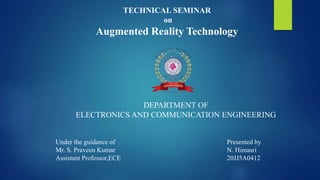
20n05a0418 ppt.pptx
- 1. TECHNICAL SEMINAR on Augmented Reality Technology DEPARTMENT OF ELECTRONICS AND COMMUNICATION ENGINEERING Under the guidance of Mr. S. Praveen Kumar Assistant Professor,ECE Presented by N. Himasri 20JJ5A0412
- 2. CONTENTS
- 3. INTRODUCTION Augmented Reality (AR) is a new technology that involves the overlay of computer graphics on the real world On the spectrum between virtual reality which creates immersible and computer generated environment .Augmented reality is closer to the real world. An AR system adds virtual computer generated objects audio and others sense enhancements to real world environment in real time. These enhancements are added in a way that viewer cannot tell the difference between real and augmented world. Augmented reality add graphics ,sounds , haptics and smell to natural world it exists. This technology will have countless applications. Everyone from the tourists to the military loops will benefit from ability to place computer generated graphics in the field of vision. The ultimate goal of the AR is to create a system that user cannot tell the difference between the real world and virtual augmentation of it.
- 4. What is Augmented reality? Augmented reality (AR) is a field of computer research which deals with combination of real world and computer generated data. Augmented reality refers to computer displays that add virtual information to a users sensory perceptions. It is a method for visual improvement or enrichment of the surrounding environment by overlaying spatially aligned computer generated information on to human view (eyes). An AR research focuses on see-through devices usually worn on the head that overlays graphics and text on the users view of his or her surroundings .In general its superimposes graphics over a real world environment in real time.
- 5. Augmented Reality vs. Virtual Reality Augmented Reality System augments the real world scene User maintains a sense of presence in real world Needs a mechanism to combine virtual and real worlds Hard to register real and virtual Virtual Reality Totally immersive environment Senses are under control of system Need a mechanism to feed virtual world to user Hard to make VR world interesting
- 6. Types of Augmented Reality This complex technology is divided into 3 main categories, each having their objectives and applicational use cases. 1. Marker less Augmented Reality : (location-based, position-based, or GPS) : The position-based augmented reality uses a GPS, digital compass, velocity meter, or accelerometer which is embedded in a certain device to provide data based on user’s location. 2. Projection-based Augmented Reality : This type of AR projects artificial light onto a real-world surface. In some cases, it detects human interaction with a projection by its alterations. 3. Superimposition-based Augmented Reality :It can partially or fully replace the original view of an object with an augmented reality object. The key point to this type of application is the recognition of the object because without determining what the object is, the original view cannot be replaced with an augmented reality one.
- 7. How Does it work ? The computer software recognizes the AR markers(black squares) that contain certain patterns measures each side and does some complex calculations to determine the position and rotation of the market in 3D space . This information allows the computer to render photo realistic 3D objects over the market and display the result in both the handheld visor and on a large computer screen . The pattern within the marker dictates pitch 3D object will be displayed and can also trigger narration and sound effects. Markets can be variety of sizes and attached to almost any flat service which means they can be used in many interesting and effective ways.
- 8. Advantages of AR People can share experiences with each other in real time over long distances Games that provide an even more "real" experience Things come to life on people's mobile AR will be used easy to use Improved Technology Educational Advantages of Augmented Reality Supports Business Activities Can increase knowledge and information
- 9. APPLICATIONS Main classes of applications: Medical Entertainment Military training Engineering design Robotics and Tele robotics Manufacturing , Maintenance and repair Consumer design
- 10. Conclusion
- 11. THANK YOU